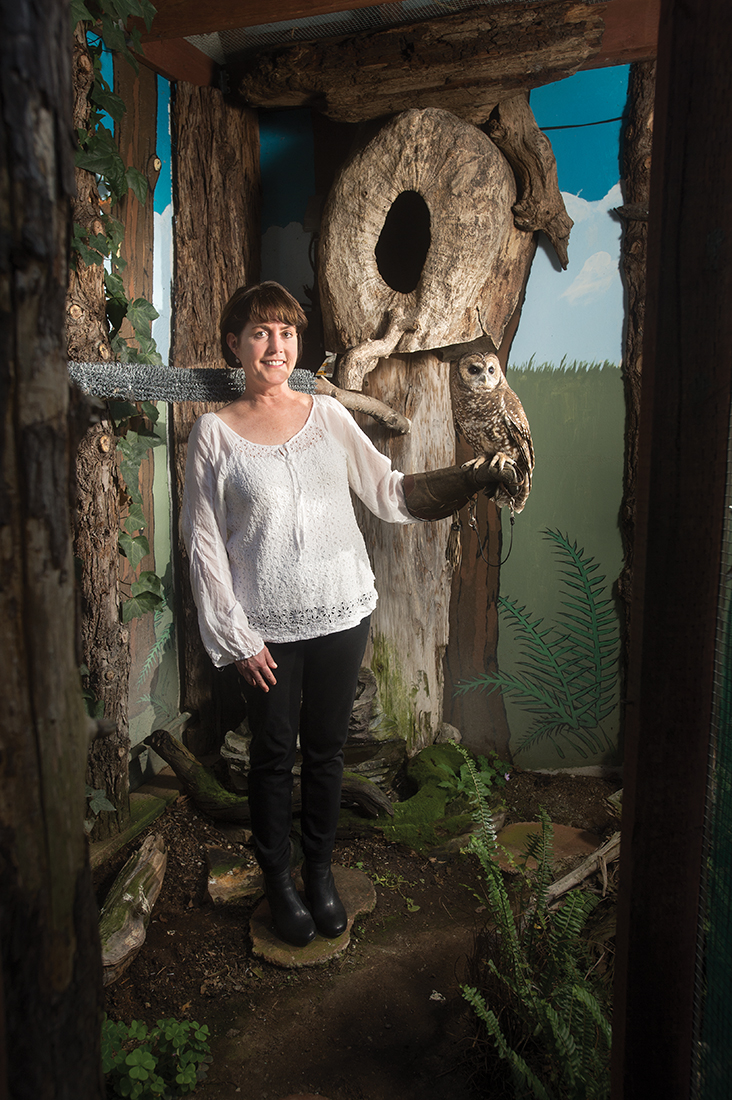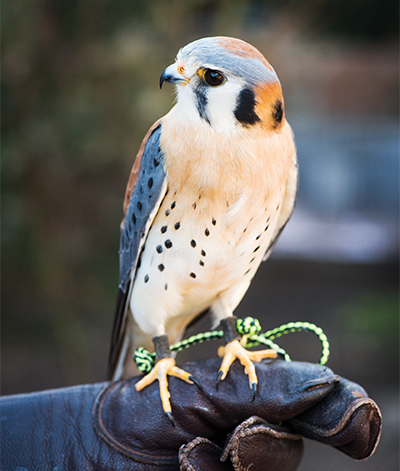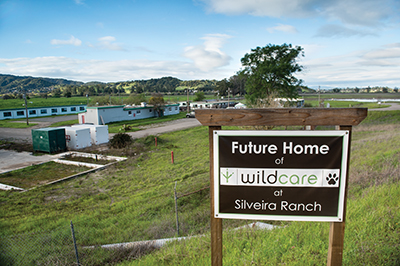 KAREN WILSON HAS helmed WildCare, the San Rafael– based wildlife rehabilitation and education center, for the past 13 years, but she didn’t start out working with nature.
KAREN WILSON HAS helmed WildCare, the San Rafael– based wildlife rehabilitation and education center, for the past 13 years, but she didn’t start out working with nature.
The suburban Detroit native began her career in advertising in Boston, but a subsequent move to San Francisco found her working in the environmental field, first as a program manager for the California Coastal Commission and later as vice president of development for the California State Parks Foundation.
Wilson oversees an organization that employs 32 people, coordinates with 350 volunteers and treats more than 4,000 injured or orphaned wild animals, representing more than 200 different species, each year. Today, she is steering WildCare through a $10 million capital campaign to build an expansive new facility in San Rafael that promises to be a major resource for wild animals, their caretakers and visitors throughout the Bay Area.
Wilson lives in Fairfax with her husband, Todd Tash, a fourth-grade teacher at Ross School, and their 3-year-old rescue dog, Wally.
What brought you to WildCare?
I had helped grow the California State Parks Foundation for 10 years when I saw an (employment) ad for WildCare. Up until then, I had never heard of it, and even though I live in Fairfax and walk the trails, I had never encountered an injured wild animal. I decided to apply and got the job. The day I walked into the facility, I knew my dream was to build a new WildCare. It was so evident at that point, but we had a lot of other things to do before we ever considered it. We needed to shore up the financial situation, grow the budgets to do better programs, build the board, expand the education program and advocate for wildlife. WildCare had never done any advocacy on a broad scale. It’s important to make a difference with individual orphaned and injured animals, but advocacy is critical.
You met Elizabeth Terwilliger, a pioneering Marin naturalist, when you first started your job at WildCare. How did that go?
A month after I joined Wildcare I went to visit her at The Redwoods in Mill Valley where she was living. She was on the board of Wildcare at the time. I spotted a pair of mallards in the creek and asked her if she thought they mated for life. Without missing a beat, Elizabeth replied, “You know, you’d have to ask them.”
What does WildCare advocate?
One of the best examples is stopping the use of rat poison. If you poison a rat, you poison a hawk, an owl, a fox or bobcat or any other predator that eats it. We test all the carnivore patients for levels of rodenticides, even if a car has hit them, and we have found that 90 percent have some level of rodenticide in their system. The Environmental Protection Agency has used our data to continue its studies on rodenticides. Now, we’re working with the California Department of Pesticide Regulation and have expanded our testing, through a network of veterinarians and their clients, to include dogs and cats. And, last year, after a number of confined tule elk in Point Reyes died when their ponds dried up, we circulated a petition to instate a policy that in the event the drying-up ever happened again, the National Park Service would provide water. We’re very proud of that.
Why is WildCare important?
We are so lucky to be in this natural world but our boundaries bump up against each other. Ninety-nine percent of the time that an animal comes through WildCare, it’s because of a negative human interaction. We’re not trying to mess with the natural order; we just fix what humans happened to do that shouldn’t have happened in the first place. There are threats to wildlife everywhere but the number one problem is cats. They prey on the songbird population so we encourage people to make changes that make that less likely to happen by keeping them inside, or in outdoor cat condos, which is safer for the cat, too.
What is your most memorable case?
Maybe it was the bobcat that was hit by a car and lay on the side of Highway 101 in San Rafael. He was unconscious when a passerby, thinking he was a large domestic cat, picked him up and put him in her car. He woke up but luckily wasn’t awake enough to do any damage. His leg was broken in two places and our veterinarians — who are all volunteers, by the way — put pins in his leg at their clinic and he was released back to the wild. That’s why this new hospital is so critical. We don’t want to have to transport animals to get care and we’re hoping to have the resources to hire a veterinarian.
What are the biggest complaints about wildlife?
Skunks, when they’re in mating season and more likely to spray, but raccoons are high up on the list. When they’re nesting and having babies, they can find their way into chimneys and other areas of a house. We encourage people to let them have their babies (skunks won’t spray in their dens) and then, after you get them all safely out of the place, to block the entrance. Most people don’t know that by law, a commercial pest control company can’t release animals it traps; it’s required to kill them. Our WildCare Solutions Service, however, will come out for a small charge, perform an inspection and seal the entrances for any Bay Area resident.

What might people not know about WildCare?
Some people might think WildCare is only about caring for animals, but just as important is our educational focus. We have 20,000 Bay Area children a year go through our educational programs. We offer field trips that are tied to science standards and our nature van goes to schools to teach children about California wildlife. We also have week-long day camps in the summer. We won’t turn down any child or school because of finances and our full scholarships include transportation.
You’re in the midst of a $10 million capital campaign but still need to raise $4 million. How are you doing that?
We’ve just hired a wonderful new development director and, besides our big donor push, we’ve come up with creative ways for donors to contribute at smaller levels. There are lots of “naming opportunities,” from metal leaves to an outdoor tree sculpture and wildlife sculptures, to spaces that still need naming including various rooms, the bird wing, the hospital, the ambassador and shorebird exhibits, a nest play structure for children, and a mother oak tree. People can name a space for themselves or in honor of their parents, grandchildren or anyone special to them.
Anything else on your wish list?
In addition to the important capital campaign, we really need new hospital equipment such as a digital X-ray machine.
You plan to move to a new location in San Rafael in 2017. Tell us how you found it.
Two previous properties we thought we had secured fell through and then Renee Silveira called two-and-a-half years ago and said her family had some space we could use. It’s a former Nike missile site built by the U.S. Army in the 1950s on land it leased from the Silveiras. Later, Renee and her mother, Lorraine, came to WildCare and said that the late Tony Silveira (Lorraine’s husband) was passionate about wildlife and that he would absolutely love and appreciate the partnership. It will be called WildCare at Silveira Ranch.
Where is it?
It’s five acres on Smith Ranch Road surrounded by seasonal wetlands and pasture. It has so much wildlife that we can enhance our programming right on site and because we’ll have the space, we won’t have to send patients off to other centers. That will be much less stressful for the animals.
How will it be different from your current location?
It’ll be great. Right now, we are so crammed for space. We only have one exam room and, in the busy spring and summer seasons, we have patients lined up inside the room and out in the halls, with predators and prey right next to each other, which isn’t good for them. We’ll move into a 36,000-square-foot space with an existing concrete block barrack and mess hall that will be renovated for our new hospital, classrooms and offices, but we’ll expand the space to build agreat hall. There will also be a Terwilliger Discovery Center, which is an interactive space for children and their families; expanded, naturalistic habitats for our ambassador animals that can’t be released; and better opportunities for the public to interact with them. We will have the space to run three simultaneous summer camps or hold a lecture or big event. And we’ll have a much better hospital for the animals.
What can visitors expect to see?
It will be a real destination where they can spend the day. They can explore the discovery center for a few hours, buy a pre-made sandwich or bring their own picnic, browse the gift shop, participate in interactive programs with the animals, and see animal patients in foster care. This is our legacy. There hasn’t been anything like this and we want WildCare to be around for generations to come and to make a positive difference for people and wildlife.
This article originally appeared in Marin Magazine’s print edition under the headline: “Karen Wilson.“


